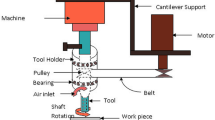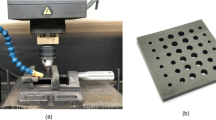Abstract
Electrochemical discharge drilling (ECDD) is a hybrid machining process for fabricating small holes in nickel-based superalloys. In this study, the effects of solution conductivity on tool electrode wear during ECDD process are investigated. The experiments are performed using deionised water and NaNO3 solutions with different conductivities as working fluids. Machining current waveforms and hole-drilling results are analysed. The aim of this study is to investigate the reduction in tool electrode wear while obtaining good quality drill holes by ECDD with suitable solution conductivity. Experimental results show that the ECDD process using a NaNO3 working fluid with a conductivity of approximately 4.0 mS/cm results in optimal quality holes with the low tool electrode wear, and the tool electrode relative wear ratio is reduced by 65.4% as the working fluid conductivity changes from 0.005 to 4.0 mS/cm.
Similar content being viewed by others
References
Dai P, Li SX (2014) Recent advances in the study of film cooling on the gas turbine blade. Adv Mater Res 971-973:143–147
Dong YW, Li XL, Zhao Q, Li XJ, Dou YQ (2017) Geometrical modeling to improve the accuracy of drilled cooling holes on turbine blades. Int J Adv Manuf Technol 93:4409–4428
Li CJ, Li Y, Tong H, Zhao L, Kong QC, Wang ZQ (2016) An EDM pulse power generator and its feasible experiments for drilling film cooling holes. Int J Adv Manuf Technol 87:1813–1821
Ay M, Çaydaş U, Hasçalık A (2013) Optimization of micro-EDM drilling of inconel 718 superalloy. Int J Adv Manuf Technol 66:1015–1023
Wen ZX, Huang S, Gao HS, Yue ZF (2017) Experimental investigation on low cycle fatigue properties of GH3536 alloy with film cooling holes in different drilling processes. Eng Fail Anal 82:190–197
Liu K, Lauwers B, Reynaerts D (2010) Process capabilities of micro-EDM and its applications. Int J Adv Manuf Technol 47(1–4):11–19
Bassoli E, Denti L, Gatto A, Iuliano L (2016) Influence of electrode size and geometry in electro-discharge drilling of Inconel 718. Int J Adv Manuf Technol 86:2329–2337
Gao Q (2018) Impact of electrode length on EDM inclined hole drilling process. Int J Adv Manuf Technol 94:1171–1175
Luis CJ, Puertas I, Villa G (2005) Material removal rate and electrode wear study on the EDM of silicon carbide. J Mater Process Technol 164:889–896
Wang CC, Chow HM, Yang LD, Lu CT (2009) Recast layer removal after electrical discharge machining via Taguchi analysis: a feasibility study. J Mater Process Technol 209:4134–4140
Zhu D, Wang W, Fang XL, Qu NS, Xu ZY (2010) Electrochemical drilling of multiple holes with electrolyte-extraction. CIRP Ann Manuf Technol 59(1):239–242
Wang XD, Qu NS, Fang XL, Li HS (2016) Electrochemical drilling with constant electrolyte flow. J Mater Process Technol 238:1–7
Fang XL, Qu NS, Zhang YD, Xu ZY, Zhu D (2014) Improvement of hole exit accuracy in electrochemical drilling by applying a potential difference between an auxiliary electrode and the anode. J Mater Process Technol 214(3):556–564
Fang XL, Qu NS, Li HS, Zhu D (2013) Enhancement of insulation coating durability in electrochemical drilling. Int J Adv Manuf Technol 68:2005–2013
He XL, Wang YK, Wang ZL, Zeng ZQ (2013) Micro-hole drilled by EDM-ECM combined processing. Key Eng Mater 562-565:52–56
Nguyen MD, Rahman M, Wong YS (2012) Simultaneous micro-EDM and micro-ECM in low-resistivity deionized water. Int J Mach Tool Manu 54-55:55–65
Nguyen MD, Rahman M, Wong YS (2013) Modeling of radial gap formed by material dissolution in simultaneous micro-EDM and micro-ECM drilling using deionized water. Int J Mach Tool Manu 66:95–101
Nguyen MD, Rahman M, Wong YS (2013) Transitions of micro-EDM/SEDCM /micro-ECM milling in low-resistivity deionized water. Int J Mach Tool Manu 69:48–56
Zhang Y, Xu ZY, Zhu D, Qu NS, Zhu Y (2016) Drilling of film cooling holes by a EDM/ECM in situ combined process using internal and side flushing of tubular electrode. Int J Adv Manuf Technol 83:505–517
Singh T, Dvivedi A (2016) Developments in electrochemical discharge machining: a review on electrochemical discharge machining, process variants and their hybrid methods. Int J Mach Tool Manu 105:1–13
Lauwers B, Klocke F, Klink A, Tekkaya AE, Neugebauer R, Mcintosh D (2014) Hybrid processes in manufacturing. CIRP Ann Manuf Technol 63:561–583
Goud M, Sharma AK, Jawalkar C (2016) A review on material removal mechanism in electrochemical discharge machining (ECDM) and possibilities to enhance the material removal rate. Precis Eng 45:1–17
Yang CK, Wu KL, Hung JC, Lee SM, Lin JC, Yan BH (2011) Enhancement of ECDM efficiency and accuracy by spherical tool electrode. Int J Mach Tool Manu 51(6):528–535
Huang SF, Liu Y, Li J, Hu HX, Sun LY (2014) Electrochemical discharge machining micro-hole in stainless steel with tool electrode high-speed rotating. Mater Manuf Process 29(5):634–637
Coteata M, Schulze H, Slatineanu L (2011) Drilling of difficult-to-cut steel by electrochemical discharge machining. Mater Manuf Process 26(12):1466–1472
Behroozfar A, Razfar MR (2016) Experimental study of the tool wear during the electrochemical discharge machining. Mater Manuf Process 31(5):574–580
Chavoshi SZ, Behagh AM (2014) A note on influential control parameters for drilling of hard-to-machine steel by electrochemical discharge machining. Int J Adv Manuf Technol 71:1883–1887
Tao XT, Liu ZD, Qiu MB, Tian ZJ, Shen LD (2018) Research on an EDM-based unitized drilling process of TC4 alloy. Int J Adv Manuf Technol 97:867–875
Jui SK, Kamaraj AB, Sundaram MM (2013) High aspect ratio micromachining of glass by electrochemical discharge machining (ECDM). J Manuf Process 15(4):460–466
Zhang Y, Xu ZY, Zhu D, Xing J (2015) Tube electrode high-speed electrochemical discharge drilling using low-conductivity salt solution. Int J Mach Tool Manu 92:10–18
Zhang Y, Xu ZY, Xing J, Zhu D (2016) Effect of tube-electrode inner diameter on electrochemical discharge machining of nickel-based superalloy. Chin J Aeronaut 29(4):1003–1110
Dong SL, Wang ZL, Wang YK (2017) High-speed electrochemical discharge drilling (HSECDD) for micro-holes on C17200 beryllium copper alloy in deionized water. Int J Adv Manuf Technol 88:827–835
Yin QF, Wang BR, Zhang YB, Liu GM (2014) Research of lower tool electrode wear in simultaneous EDM and ECM. J Mater Process Technol 214(8):1759–1768
Funding
This research was sponsored by the National Natural Science Foundation of China (51475237), China, Outstanding Youth Foundation of Jiangsu province of China (BK20170031), China, Fundamental Research Funds for the Central Universities (NE2014104), China, and Postgraduate Research & Practice Innovation Program of Jiangsu Province (KYCX18_0258), China.
Author information
Authors and Affiliations
Corresponding author
Ethics declarations
Conflict of interest
The authors declare that they have no conflicts of interest.
Additional information
Publisher’s note
Springer Nature remains neutral with regard to jurisdictional claims in published maps and institutional affiliations.
Rights and permissions
About this article
Cite this article
Zhang, C., Xu, Z., Hang, Y. et al. Effect of solution conductivity on tool electrode wear in electrochemical discharge drilling of nickel-based alloy. Int J Adv Manuf Technol 103, 743–756 (2019). https://doi.org/10.1007/s00170-019-03492-w
Received:
Accepted:
Published:
Issue Date:
DOI: https://doi.org/10.1007/s00170-019-03492-w




